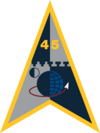
Back Kaap Canaveral- ruimtemagstasie Afrikaans Cape Canaveral Air Force Station ALS قاعدة كيب كانافيرال للقوات الجوية Arabic Kanaveral hərbi hava qüvvələri bazası Azerbaijani База ВПС ЗША на мысе Канаверал Byelorussian Кейп Канаверал (авиобаза) Bulgarian কেপ ক্যানাভেরাল স্পেস ফোর্স স্টেশন Bengali/Bangla Estació de la Força Espacial de Cap Canaveral Catalan Cape Canaveral Air Force Station CEB Cape Canaveral Space Force Station Czech
Parts of this article (those related to History → Subsequent activity) need to be updated. The reason given is: The section ends with 2014 in future tense. (November 2022) |
| Cape Canaveral Space Force Station | |||||||
|---|---|---|---|---|---|---|---|
| Part of Patrick Space Force Base | |||||||
| Near Cocoa Beach, Florida in the United States | |||||||
 Emblem of Space Launch Delta 45 | |||||||
| Coordinates | 28°29′20″N 80°34′40″W / 28.48889°N 80.57778°W | ||||||
| Type | U.S. Space Force Station | ||||||
| Area | 1,325 acres (5 km2)[1] | ||||||
| Site information | |||||||
| Owner | Department of Defense | ||||||
| Operator | United States Space Force | ||||||
| Controlled by | Space Launch Delta 45 | ||||||
| Condition | Operational | ||||||
| Website | www | ||||||
| Site history | |||||||
| Built | 1949 (as the Joint Long Range Proving Ground) | ||||||
| In use | 1949 – present | ||||||
| Garrison information | |||||||
| Garrison | Space Launch Delta 45 | ||||||
| Airfield information | |||||||
| Identifiers | ICAO: KXMR, FAA LID: XMR | ||||||
| Elevation | 3 metres (10 ft) AMSL | ||||||
| |||||||
| Source: Federal Aviation Administration[2] | |||||||
Cape Canaveral Space Force Station | |||||||
| Location | Cape Canaveral, Florida, United States | ||||||
| Built | 1950+[3] | ||||||
| Visitation | Not open to the public | ||||||
| NRHP reference No. | 84003872[1] | ||||||
| Significant dates | |||||||
| Added to NRHP | April 16, 1984 | ||||||
| Designated NHLD | April 16, 1984[4] | ||||||
| Part of a series on the |
| United States space program |
|---|
  |
Cape Canaveral Space Force Station (CCSFS) is an installation of the United States Space Force's Space Launch Delta 45, located on Cape Canaveral in Brevard County, Florida.
Headquartered at the nearby Patrick Space Force Base, the station is the primary launch site for the Space Force's Eastern Range[5] with three launch pads currently active (Space Launch Complexes 37B, 40, and 41). The facility is south-southeast of NASA's Kennedy Space Center on adjacent Merritt Island, with the two linked by bridges and causeways. The Cape Canaveral Space Force Station Skid Strip provides a 10,000-foot (3,000 m) runway[6] close to the launch complexes for military airlift aircraft delivering heavy and outsized payloads to the Cape.
A number of American space exploration pioneers were launched from CCSFS, including the first U.S. Earth satellite (1958), first U.S. astronaut (1961), first U.S. astronaut in orbit (1962), first two-man U.S. spacecraft (1965), first U.S. uncrewed lunar landing (1966), and first three-man U.S. spacecraft (1968). It was also the launch site for all of the first spacecraft to (separately) fly past each of the planets in the Solar System (1962–1977), the first spacecraft to orbit Mars (1971) and roam its surface (1996), the first American spacecraft to orbit and land on Venus (1978), the first spacecraft to orbit Saturn (2004), and to orbit Mercury (2011), and the first spacecraft to leave the Solar System (1977). Portions of the base have been designated a National Historic Landmark for their association with the early years of the American space program.[7]
Cape Canaveral was known as Cape Canaveral Launch Area upon its foundation in 1949, but renamed to LRPG Launching Area in 1950. It was known as Cape Canaveral Auxiliary Air Force Base from 1951 to 1955, and Cape Canaveral Missile Test Annex from 1955 to 1964. The facility was later known as Cape Kennedy Air Force Station from 1964 to 1974, and as Cape Canaveral Air Force Station from 1974 to 1994 and from 2000 to 2020, taking the designation Cape Canaveral Air Station from 1994 to 2000.[8][9][10] The facility was renamed "Cape Canaveral Space Force Station" in December 2020.[11][12]
- ^ a b "National Register Information System – (#84003872)". National Register of Historic Places. National Park Service. July 9, 2010.
- ^ "Cape Canaveral AFS Skid Strip (KXMR)" (PDF). Federal Aviation Administration. September 12, 2019. Archived from the original (PDF) on September 19, 2019. Retrieved September 14, 2019.
- ^ "Cape Canaveral Air Force Station". Florida Heritage Tourism Interactive Catalog. Florida's Office of Cultural and Historical Programs. September 23, 2007. Archived from the original on December 14, 2007.
- ^ Cape Canaveral Air Force Station Archived January 13, 2009, at the Wayback Machine at National Historic Landmarks Program.
- ^ CAST 1999, p. 1-12.
- ^ "World Aero Data: Cape Canaveral AFS Skid Strip – XMR". Archived from the original on October 4, 2012. Retrieved August 31, 2008.
{{cite web}}: CS1 maint: unfit URL (link) - ^ "NHL nomination for Cape Canaverl Air Force Station". National Park Service. Retrieved January 11, 2018.
- ^ Lethbridge, Cliff. "Cape Canaveral Name Changes". Retrieved September 25, 2023.
- ^ "ASSURED ACCESS TO SPACE: The Heritage of the Eastern Range from World War II to the Present" (PDF). Patrick SFB. Space Launch Delta 45 History Office. May 31, 2022. p. 6. Retrieved November 20, 2023.
- ^ Historic American Engineering Record (HAER) No. FL-8-5, "Cape Canaveral Air Station, Launch Complex 17, East end of Lighthouse Road, Cape Canaveral, Brevard, FL"
- ^ Joy, Rachael (December 9, 2020). "Vice President Pence announces official name change of Patrick Space Force Base". Florida Today. Retrieved December 10, 2020.
- ^ Dunn, Marcia (March 26, 2020). "Space Force launches its first mission with virus precautions". CTV News. Retrieved May 14, 2020.
© MMXXIII Rich X Search. We shall prevail. All rights reserved. Rich X Search
